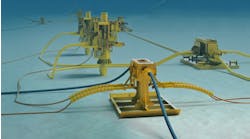Offshore staff
DHAHRAN, Saudi Arabia – Saudi Aramco has outlined some recent technical achievements in its 2017 annual report.
In the Red Sea, using an autonomous system that deployed seismic nodes on the seabed via reinforced armored rope, the company cut the costs of 3D seismic data acquisition over two blocks, measuring respectively 800 sq km (309 sq mi) and 900 sq km (347 sq mi).
The choice of locations for the 3D seismic survey was based on results from a large-scale hydrographic survey, a first for these waters, the company said.
Aramco expects the survey results will help it optimize field operations and facilities, including rig movements, laying of pipelines, and supply vessel routes.
At the same time, the company has been continuing efforts to develop secondary reservoirs, such as ‘Ain Dar and Lower Fadhili, and to optimize surface facilities.
In this regard it upgraded various offshore platforms, installed new tie-in platforms, and replaced main trunk lines serving the offshoreSafaniyah field.
It also completed a major project to de-mothball one of the gas-oil separation plants (GOSPs) at the offshore Zuluf field.
Production from GOSP-3 had been suspended in 1995. During a six-month program, Aramco’s team inspected, repaired, and installed new equipment and utilities to bring GOSP-3 safely back online to sustain the field production capacity at 800,000 b/d of crude.
08/22/2018


